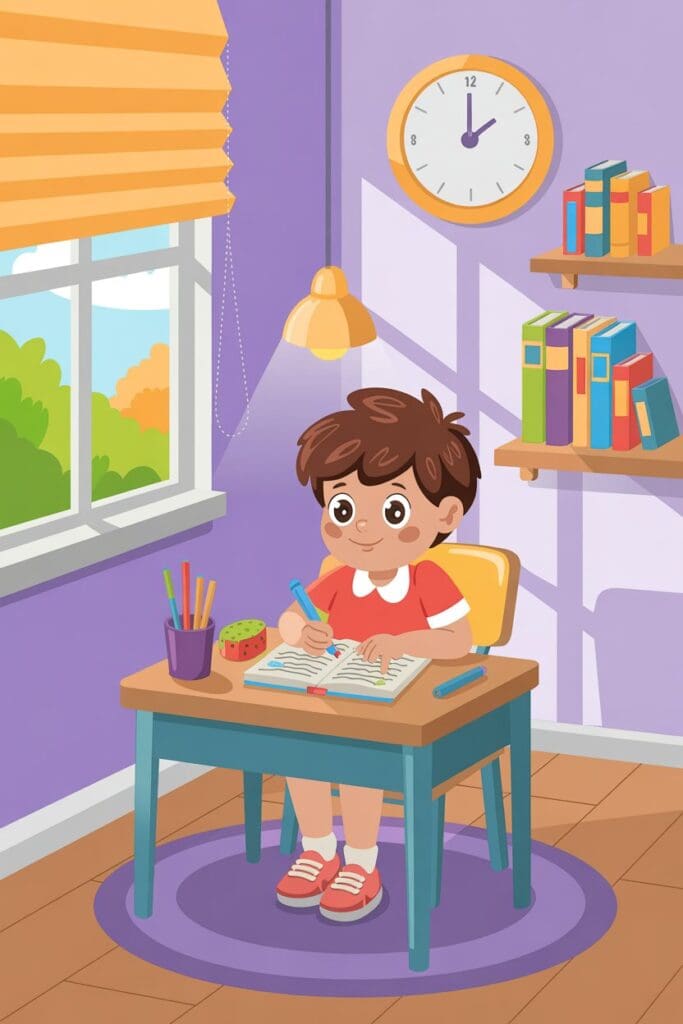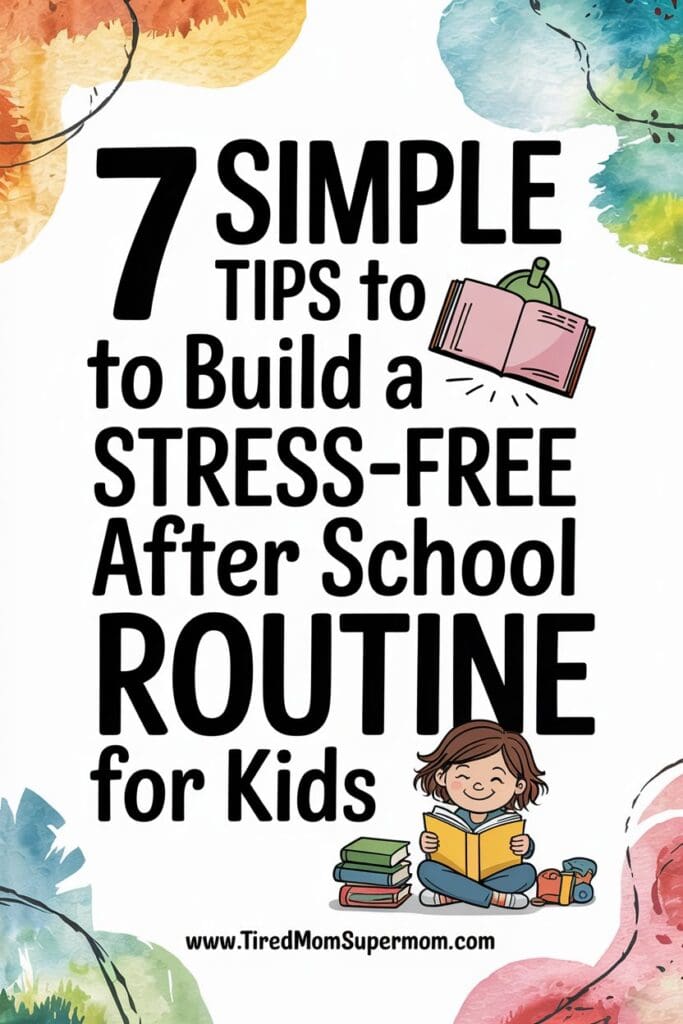7 Easy Tips To Build a Stress-Free After School Routine for Kids
The after school hours can often feel chaotic for families — but creating a calm, structured after school routine for kids can transform your evenings.
With three busy children at home, I’ve learned firsthand how powerful a consistent, screen-free afternoon can be.
Today, I’m sharing the simple strategies that helped us reclaim peaceful afternoons and encourage better behavior after school.
Let’s dive into these seven actionable tips!
Heads up: This post may include affiliate links. As an Amazon Associate, I earn from qualifying purchases—at no extra cost to you. Full privacy policy and disclosure here.

1. Start With a Healthy Snack Break
Children come home from school hungry, tired, and sometimes cranky. Setting up a healthy after school snack break can help prevent meltdowns and refuel their energy. Keep a few easy snacks ready to go, such as:
- Apple slices and peanut butter
- Greek yogurt with berries
- Whole grain crackers and cheese
We love using these colorful bento snack containers to portion snacks in advance. It cuts down on kitchen chaos and encourages independent eating!
According to the American Academy of Pediatrics, providing balanced, nutritious snacks is essential for growing minds after a busy school day.
2. Set Up a Relaxed Transition Time
After the snack, give kids a short 15–20 minute decompression window before homework or chores. This can include:
- Playing outside
- Drawing or coloring
- Listening to music
Creating this relaxed transition period gives kids time to unwind and switch gears. It’s a small step that makes the whole after school routine for kids smoother.
Need an easy backyard solution? We added a durable backyard swing set to our yard for outdoor play, and it’s been a total game-changer.
The Genius of Play emphasizes that free play is crucial for emotional regulation, so don’t skip this!
3. Create a Homework Station
Homework battles can derail even the best after school routines. Setting up a designated homework station makes a huge difference.
Here’s what we included:
- Comfortable adjustable kids’ desks
- Good lighting
- Quiet, distraction-free environment
If you’re struggling with homework resistance, check out 7 Easy Steps to a Stress-Free Homework Routine. It offers simple, sanity-saving tips!
Keep the homework session short — around 20–30 minutes per subject — and sprinkle in mini-breaks if needed.
4. Organize Backpack and Papers Immediately
Nothing destroys a peaceful evening faster than realizing at bedtime that you forgot about a permission slip or missing homework!
Make it part of your after school routine for kids to:
- Empty backpacks
- Sort papers
- Prep folders for the next day
A few simple backpack wall hooks in your entryway or mudroom can keep school clutter under control.
Plus, involving kids teaches responsibility and organization — lifelong skills that pay off.
5. Plan for Screen Time Strategically
Screens aren’t evil, but they need to be used mindfully. In our house, screens are earned after:
- Snack
- Outdoor time
- Homework
- Chores
You can create a simple screen time ticket system, or allow 30–45 minutes of approved shows, educational games, or family movies.
Want to create a bigger routine system? Family meetings are a great place to set expectations about screen time boundaries in a positive way.
6. Build in Chore Time (Even Small Ones)
Kids thrive on contribution. Small, predictable chores after school help teach responsibility without overwhelming them.
Some ideas:
- Feeding pets
- Setting the table
- Taking out the recycling
Consider using a simple magnetic chore chart to make it visual and motivating.
Pro tip: Keep it short — 5–10 minutes max. After all, kids have already had a full day of “work” at school!
7. Set Up an Evening Wind-Down Routine
After a busy afternoon, children need a gentle evening routine to transition into bedtime.
A peaceful after school and evening flow could look like:
- Dinner
- Family time
- Bath or shower
- Bedtime stories
- Lights out
Setting up a great after school routine makes evenings feel smooth and connected. If bedtime is still a struggle, check out How to Create a Bedtime Routine for Multiple Kids — it has fantastic layered routines for large families.
After School Routine FAQ
What is the best age to start an after school routine for kids?
You can begin simple routines as early as preschool. Even a basic snack-play-bath sequence can make a huge difference. The key is consistency, not complexity.
How long should an after school routine be?
Most routines last around 2–3 hours depending on homework, activities, and family dinner time. It’s more about the flow (and flexibility) than rigid schedules.
Should I allow screen time immediately after school?
It’s better to prioritize outdoor play, a snack, and homework first. Screens can be used as an incentive or calming tool once the essential tasks are completed.
How can I help my child stick to an after school routine?
Use visual schedules, verbal reminders, and lots of positive reinforcement. Consistency is key! Family meetings can also help reinforce expectations.
How do I customize the routine for multiple kids?
Plan staggered individual times for tasks like showers or homework, but keep communal activities like snack time and outdoor play together.
Sample After School Routine for Kids
Here’s a realistic example to get you started:
| Time | Activity |
|---|---|
| 3:30 PM | Healthy snack |
| 3:50 PM | Outdoor play or decompression time |
| 4:30 PM | Homework and reading |
| 5:15 PM | Chores |
| 5:30 PM | Dinner |
| 6:00 PM | Family time (games, free play) |
| 7:00 PM | Bath, pajamas, story time |
| 8:00 PM | Lights out |
Final Thoughts
Creating a positive after school routine for kids doesn’t have to be complicated. A few simple structures — like snack breaks, outdoor time, and clear homework systems — can make afternoons flow so much more smoothly.
Start with just one or two changes this week. Watch how your kids respond to the calmer rhythm — and how much more peaceful your family evenings become!
If you found this post helpful, you may also love reading about creating a School Morning Routine That Actually Works.
Transform Your Evenings: Easy After School Routine for Kids You’ll Actually Stick To! 🌟 Save This Now!

What does your after school routine for kids look like? Share your favorite tips or challenges in the comments — I’d love to hear how you make your afternoons flow more smoothly!
